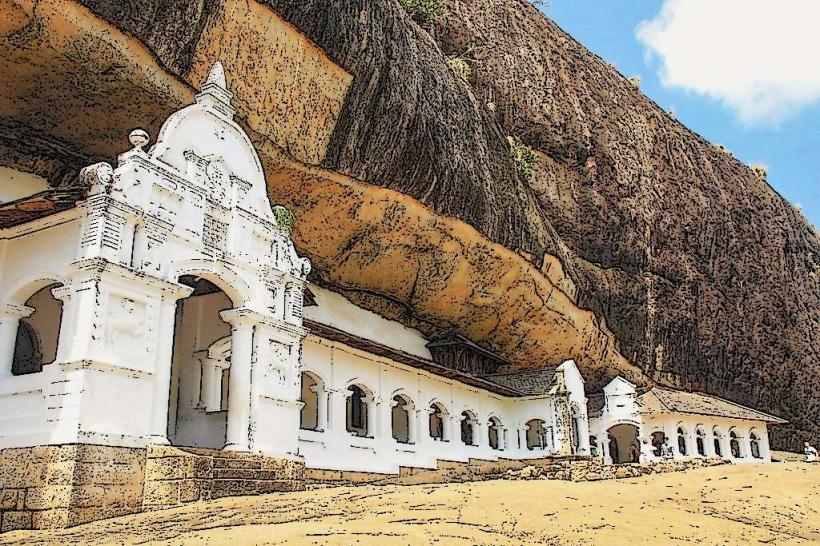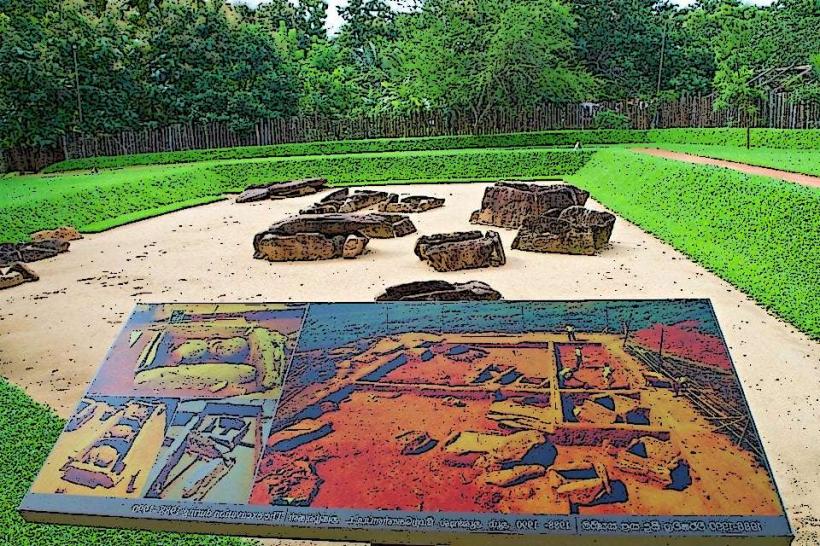Information
Landmark: Golden Temple of DambullaCity: Dambulla
Country: Sri Lanka
Continent: Asia
The Golden Temple of Dambulla, also known as the Dambulla Cave Temple, is one of Sri Lanka's most iconic and historically significant Buddhist sites. It is famous for its impressive collection of cave temples adorned with exquisite Buddhist statues and murals, as well as the striking Golden Buddha statue that stands at the entrance.
1. Overview
- Location: Dambulla, Matale District, Sri Lanka. It is about 148 km (92 miles) northeast of Colombo and 72 km (45 miles) from Kandy.
- UNESCO World Heritage Site: The Golden Temple of Dambulla is recognized as a UNESCO World Heritage Site due to its outstanding cultural, historical, and religious significance.
- Historical Significance: The temple complex dates back to the 1st century BCE and has been continuously used as a place of worship for over two millennia. It is an important Buddhist pilgrimage site.
2. The Golden Buddha Statue
- Height: The Golden Buddha statue is an impressive 27 meters (88 feet) tall, making it one of the tallest Buddha statues in Sri Lanka.
- Location: The statue is located at the entrance to the temple complex, positioned on top of a hill, and is visible from a great distance.
- Symbolism: The statue represents the enlightened state of Buddha and acts as a welcoming figure for all who come to the temple. It is made of bronze and painted gold, symbolizing Buddha's teachings and purity.
3. The Cave Temple Complex
The temple is built into a massive rock and consists of five main caves. Each cave is filled with a stunning collection of Buddhist statues, murals, and intricate artwork. The caves are spread over a 160-meter (525-foot) rock and contain some of the finest examples of ancient Buddhist art in Sri Lanka.
Cave 1: The Divine King’s Cave
- This is the largest and most significant cave, housing a massive statue of Buddha in a seated meditation posture. The cave is decorated with murals and smaller statues depicting various Buddhist deities.
Cave 2: The Cave of the Great Kings
- Known for its reclining Buddha statue and large murals, this cave also contains several other statues of Buddha, and it tells the story of King Valagamba's victory after taking refuge here during his exile.
Cave 3: The Cave of the Warrior Kings
- This cave is home to a series of smaller Buddha statues, each representing significant events in Buddha's life. The murals depict Jataka tales, stories from the Buddha’s past lives.
Cave 4: The Cave of the Sacred Tooth
- This cave features murals and statues related to Buddha’s relics, including the Tooth Relic of the Buddha. The relic is of immense spiritual importance to Buddhists.
Cave 5: The Cave of the Deity
- The last cave contains depictions of the Hindu gods in addition to Buddhist figures. It reflects the religious diversity of Sri Lanka, where Hinduism and Buddhism have long coexisted.
4. Frescoes and Murals
- The cave ceilings are adorned with ancient frescoes that cover over 2,100 square meters. These murals depict various aspects of Buddha’s life, including his birth, enlightenment, and death, along with significant events in Buddhist history.
- Jataka Tales: These murals vividly illustrate the Jataka tales, which are stories of the previous lives of Buddha.
- The frescoes feature a distinct Sri Lankan style with vibrant colors and intricate detailing, which have been preserved over centuries.
5. Historical Context
- The temple complex was established by King Valagamba in the 1st century BCE, during his reign after he sought refuge in the caves to escape an invasion. After regaining his throne, he transformed the caves into a major Buddhist temple.
- Over the centuries, the temple has been expanded and renovated, with additions made by various kings during the Anuradhapura and Polonnaruwa periods.
6. Visiting the Golden Temple
Climbing to the Caves:
- Visitors must climb approximately 350 steps to reach the cave complex. The climb takes about 10 to 15 minutes and is not overly strenuous, though it can be hot during midday.
- As you ascend, there are several viewpoints offering panoramic views of the surrounding Dambulla town, Sigiriya, and the central plains.
Dress Code and Etiquette:
- As with all religious sites in Sri Lanka, visitors are required to dress modestly. Shoulders and knees must be covered, and shoes must be removed before entering the temple.
- Silence and respect for the sacred space are expected, especially when inside the cave temples.
7. Best Time to Visit
- Dry Season (May to September): The weather is ideal for outdoor activities like the climb to the caves and enjoying the views of the surrounding landscape.
- Early Morning or Late Afternoon: The temple is less crowded, and the cooler temperatures make it more comfortable to explore.
8. Nearby Attractions
- Sigiriya Rock Fortress: A UNESCO World Heritage Site located about 20 km (12 miles) from Dambulla, Sigiriya is one of Sri Lanka's most iconic landmarks, featuring ancient ruins on top of a rock plateau.
- Minneriya National Park: A popular wildlife sanctuary about 1 hour’s drive from Dambulla, famous for its large elephant herds.
- Popham's Arboretum: A beautiful botanical garden in Dambulla, perfect for nature lovers.
- Kandalama Lake: Located near the temple, Kandalama Lake is ideal for a peaceful boat ride or to enjoy the natural surroundings.
9. Tips for Visiting
- Footwear: Wear comfortable shoes suitable for climbing and remove them before entering the temple.
- Sun Protection: The climb can be hot, so bring sunscreen, a hat, or sunglasses.
- Hydration: Carry water, especially if visiting in the afternoon heat.
- Respect Local Customs: Be respectful when taking photographs and while inside the temple areas.
10. Why Visit the Golden Temple of Dambulla?
- Rich History and Culture: The temple offers a fascinating journey into Sri Lanka’s ancient Buddhist traditions, art, and architecture.
- Exquisite Art and Murals: The intricate murals and statues are some of the finest examples of ancient Sri Lankan art.
- Spiritual Significance: As a place of worship and pilgrimage, the Golden Temple offers a deeply spiritual experience.
- Stunning Views: The climb up to the temple rewards visitors with breathtaking views of the surrounding countryside.
The Golden Temple of Dambulla is a must-visit destination for anyone interested in exploring Sri Lanka's rich cultural and religious heritage. Its combination of historical significance, beautiful art, and tranquil surroundings makes it a unique and memorable site.



